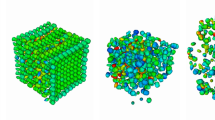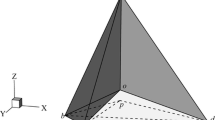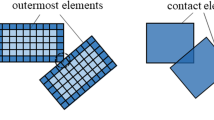Abstract
The work is devoted to a coupling method for the finite element method (FEM) and the distance potential discrete element method. In this work, a well-defined distance potential function is developed. Meanwhile, a holonomic and precise algorithm for contact interaction is established, accounting for the influence of the tangential contact force. In addition, the measurement of deformation behaviors of each discrete element is handled by the FEM, where the coupling model and the conversion method of the equivalent nodal force accounting for the influence of contact forces are proposed to generate the corresponding equations of motion. Finally, the velocity verlet algorithm is applied enabling the significant simplification for the calculation of the equations of motion. The proposed approach provides an accurate contact interaction avoiding the influence of the element shape and reflect the movement procedure of multiple deformable bodies precisely. This viewpoint is proved by the classical benchmark cases.



































Similar content being viewed by others
References
Tang XH, Paluszny A, Zimmerman RW (2014) An impulse-based energy tracking method for collision resolution. Comput Methods Appl Mech Eng 278:160–185
Chen LP, Li XJ, Zhang YH, Chen TW, Xiao SY, Liang HJ (2018) Morphological and mechanical determinants of cellular uptake of deformable nanoparticles. Nanoscale 10:11969–11979
Cundall PA, Strack ODL (1979) A discrete numerical model for granular assemblies. Géotechnique 29:47–65
Cundall PA (1988) Formulation of a three-dimensional distinct element model—part I. A scheme to detect and represent contacts in a system composed of many polyhedral blocks. Int J Rock Mech Min Sci Geomech Abstracts 25:107–116
Hart R, Cundall PA, Lemos J (1988) Formulation of a three-dimensional distinct element model—part II. Mechanical calculations for motion and interaction of a system composed of many polyhedral blocks. Int J Rock Mech Min Sci Geomech Abstracts 25:117–125
Smoljanovic H, Zivaljic N, Nikolic Z, Munjiza A (2018) Numerical analysis of 3D dry-stone masonry structures by combined finite-discrete element method. Int J Solids Struct 136:150–167
Zhao LH, Liu XN, Mao J, Xu D, Munjiza A, Avital E (2018) A novel contact algorithm based on a distance potential function for the 3D discrete-element method. Rock Mech Rock Eng 51:3737–3769
Zhao LH, Liu XN, Mao J, Shao LY, Li TC (2020) Three-dimensional distance potential discrete element method for the numerical simulation of landslides. Landslides 17:361–377
Bao HR, Zhao ZY (2012) The vertex-to-vertex contact analysis in the two-dimensional discontinuous deformation analysis. Adv Eng Softw 45:1–10
Munjzia A, Owen DRJ (1995) A combined finite-discrete element method in transient dynamics of fracturing solids. Int J Eng Comput 12:145–174
Munjiza A, Andrews KRF (1998) NBS contact detection algorithm for bodies of similar size. Int J Numer Methods Eng 43:131–149
Munjzia A (2004) The combined finite-discrete element method. Wiley, Chichester
Smoljanovic H, Nikolic Z, Zivaljic N (2015) A finite-discrete element model for dry stone masonry structures strengthened with steel clamps and bolts. Eng Struct 90:117–129
Barla M, Piovano G, Grasselli G (2012) Rock slide simulation with the combined finite-discrete element method. Int J Geomech 12:711–721
Vyazmensky A, Stead D, Elmo D, Moss A (2010) Numerical analysis of block caving-induced instability in large open pit slopes: a finite element/discrete element approach. Rock Mech Rock Eng 43:21–39
Fathani TF, Karnawati D, Wilopo W (2016) An integrated methodology to develop a standard for landslide early warning systems. Nat Hazard Earth Sys 16:2123–2135
Mao J, Zhao LH, Di YT, Liu XN, Xu WY (2020) A resolved CFD-DEM approach for the simulation of landslides and impulse waves. Comput Methods Appl Mech Eng 359
Mao J, Zhao LH, Liu XN, Avital E (2020) A resolved CFDEM method for the interaction between the fluid and the discontinuous solids with large movement. Int J Numer Meth Eng 121:1738–1761
Zhao LH, Liu XN, Mao J, Xu D, Munjiza A, Avital E (2018) A novel discrete element method based on the distance potential for arbitrary 2D convex elements. Int J Numer Methods Eng 115:238–267
Yan CZ, Zheng H (2017) A new potential function for the calculation of contact forces in the combined finite-discrete element method. Int J Numer Anal Meth Geomech 41:265–283
Xiang J, Munjiza A, Latham J (2009) Finite strain, finite rotation quadratic tetrahedral element for the combined finite–discrete element method. Int J Numer Methods Eng 79:946–978
Dasgupta G (2003) Interpolants within convex polygons: wachspress’ shape functions. J Aerospace Eng 16:1–8
Allen MP, Tildesley DJ (1987) Computer simulation of liquids. Oxford University Press, Oxford
Euser B, Rougier E, Zhou L, Knight EE, Frash LP, Carey JW, Viswanathan H, Munjiza A (2019) Simulation of fracture coalescence in granite via the combined finite—discrete element method. Rock Mech Rock Eng 52:3213–3227
Feng YT, Han K, Owen DRJ (2012) Energy-conserving contact interaction models for arbitrarily shaped discrete elements. Comput Methods Appl Mech Eng 205:169–177
Zienkiewicz OC, Taylor RL, Zhu JZ (2005) The finite element method: its basis and fundamentals. Elsevier Butterworth-Heinemann, Amsterdam
Munjiza A, Rougier E, Knight EE (2015) Large strain finite element method: a practical course. Wiley, Chichester
Komodromos P (2005) A simplified updated Lagrangian approach for combining discrete and finite element methods. Comput Mech 35:305–313
Bathe K, Ramm E, Wilson EL (1975) Finite element formulations for large deformation dynamic analysis. Int J Numer Methods Eng 9:353–386
Xu W, Zang MY (2014) Four-point combined DE/FE algorithm for brittle fracture analysis of laminated glass. Int J Solids Struct 51:1890–1900
Brezeanu LC (2015) Contact stresses between two cylindrical bodies: cylinder and cylindrical cavity with parallel axes—part I: theory and FEA 3D modeling. Procedia Technol 19:169–176
Jiang Y, Herrmann HJ, Alonsomarroquin F (2018) A boundary-spheropolygon element method for stress determination and breakage modelling of particles. arXiv: Soft Condensed Matter (2018)
Galindo-Torres SA, Alonso-Marroquin F, Wang YC, Pedroso D, Castano JDM (2009) Molecular dynamics simulation of complex particles in three dimensions and the study of friction due to nonconvexity. Phys Rev E 79:060301
Alonso-Marroquin F (2008) Spheropolygons: a new method to simulate conservative and dissipative interactions between 2D complex-shaped rigid bodies. Epl-Europhys Lett 83:14001
Acknowledgements
This work is supported by the National Key R&D Program of China (Grant 2018YFC0406705), China Postdoctoral Science Foundation Funded Project (Grant 2019M651677), the 15th Fok Ying-Tong Education Foundation for Young Teachers in the Higher Education Institutions of China (Grant 151073), the Priority Academic Program Development of Jiangsu Higher Education Institutions (Grant YS11001), the 111 Project and Qing Lan Project.
Author information
Authors and Affiliations
Corresponding author
Additional information
Publisher's Note
Springer Nature remains neutral with regard to jurisdictional claims in published maps and institutional affiliations.
Rights and permissions
About this article
Cite this article
Liu, X., Mao, J., Zhao, L. et al. The distance potential function-based finite-discrete element method. Comput Mech 66, 1477–1495 (2020). https://doi.org/10.1007/s00466-020-01913-2
Received:
Accepted:
Published:
Issue Date:
DOI: https://doi.org/10.1007/s00466-020-01913-2




